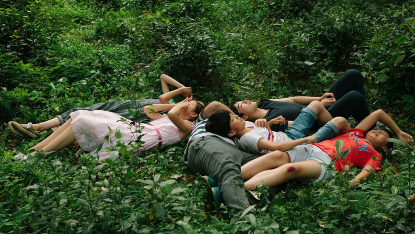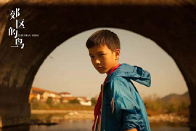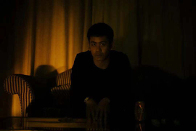DEGREE PROJECT - Film Review | Suburban Birds: City, People, and Space-time
Down by the canal, the grown ups are hunting birds.
“Suburban Birds”

A still from Suburban Birds. From Wikipedia.
Suburban Birds, the feature debut of Chinese writer-director Qiu Sheng, is a blender of coming-of-age and mystery drama. The film was highly anticipated for starring Mason Lee, the son of three-time Academy Award-winning director Ang Lee, and Lu Huang, a highly recognized Chinese literary film actress. With such high-profile stars, the film would gain anticipated success from the very beginning. It debuted with a splash at The Portland International Film Festival and New Directors, where the latest and greatest films in the world gather annualy. The New York Times praised Qiu for a “spectacular directing debut.” The film also gained a high score of 83% on the review site Rotten Tomatoes.
However, in its domestic market, the response to this debut film is lukewarm.
After dozens of postponements since 2018, Suburban Birds was finally released on February 26th this year in mainland China. This is because the risk-averse film industry was reluctant to invest in this indie film, seeing it as a hard sell. By the time the film was off the big screen, it had grossed a measly 490,000 RMB ($75,000) at the box office.
This lack of popularity of Suburban Birds hints at an embarrassing status that the Chinese audience lack of interest in literary films.
In a departure from the traditional narrative of films, Suburban Birds adopts a flexible but somewhat perplexing double storyline structure. Xia Hao (Li Meisen) and his team are young engineers trying to deal with land slide caused by a local infrastructure project. In tandem with this storyline is another story that takes place in the same suburban landscape, where a young boy, also named Hao, is searching with his playmates for a missing friend in the ruins of a destroyed community. As these two stories unfold, they occasionally overlap. Is Xia Hao, the common character who links the two stories, the same person in his youth and adulthood? Or are they actually two completely different people with the same name? It’s a mystery, and the movie is certainly in no hurry to solve it.


The film stands out for its unique shooting style. In its opening shot, there appears a blurred-edged circle inside a square frame, with a cityscape in the distance. A man finally steps into the frame and the view swivels. We can quickly discover that the view of the film is through a surveyor’s level, imitating the lens of the theodolite employed by Xia Hao and his colleagues. When adopting the classic 4:3 frame, the cinematographer boldly uses many rapid changes of lenses: in the adult storyline, there are plenty of jittery zooms and abrupt cuts cutting of the shots, hinting at the inner anxiety felt by people who are undergoing rapid social change; In the youth storyline, serene and slowed tracking and panning are used, indicating the simplicity and beauty of childhood. Freely mixing tones and lighting styles – color-rich, bright childhood scenes and bleak, gloomy adult scenes – the film further separates the youthful vitality of children with the seemingly oppressive urbanization of the adults. Through the gradual changes of natural lighting and color, we can witness a vibrant and green city gradually turning into a gray world made of machines and concrete.

Abstract neon lights shine on the faces of confused and anxious adults
The slow pace, slack plot and fuzzy imagery are most people’s intuitive feelings towards Suburban Birds. But one detail actually offers us a perfect angle to perceive the film. In the youth storyline, the elementary school girl Fang Ting once told her classmate Xia Hao that if he can solve the riddle, they can start a romantic relationship. The riddle is: “What thing in the world is the longest, but also the shortest; the fastest, but also slow; very important, but often forgotten?” Later, in the adult storyline, the grown-up Xia Hao sees the riddle again in an abandoned amusement park. Both the younger Xia Hao and the grown-up Xia Hao don’t know its answer.
In the post-credits scene, we finally learn that the answer is “time”.
At this point, we might say that the reason why the film’s pace is so sluggish while the plot is so aimless is that the film is trying to demonstrate the meaning of “time” for both teenagers and adults. These two groups never have a sense of urgency and crisis in their respective study and work, and “time” has become a cheap commodity that can be squandered at will. The area where those primary school students live is facing demolition and gradually becomes a brand-new suburb. In the midst of these vicissitudes of time, the two groups of characters are unresponsive or even unaware of it. Such reaction coincides with the feature of “time”: it is the longest, but also the shortest; the fastest, but also slow; very important, but often forgotten.
Suburban Birds is clearly a representative of the strong innovation in the form of Chinese films in the new era. Its bold shooting style and novel story construction make it a work worthy of public attention and discussion.
